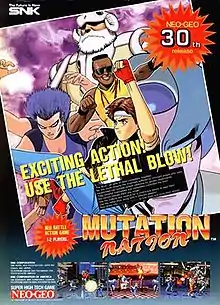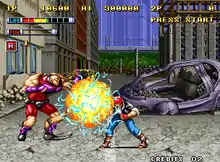Mutation Nation
Mutation Nation[lower-alpha 1] is a beat 'em up arcade game that was developed and released by SNK for the Neo Geo Japanese arcade and home systems in 1992 while the English versions were released in 1992.[1]
| Mutation Nation | |
|---|---|
 | |
| Developer(s) | SNK |
| Publisher(s) | SNK HAMSTER Corporation (PS4/Switch/Xbox One) |
| Producer(s) | Eikichi Kawasaki |
| Designer(s) | Kenji Ishimoto |
| Programmer(s) | Akio Ooi |
| Artist(s) | J. Mikami Masato Miyoshi R. Miyazaki |
| Composer(s) | Masahiko Hataya |
| Platform(s) | |
| Release | |
| Genre(s) | Beat 'em up |
| Mode(s) | |
| Arcade system | Neo Geo MVS |
Gameplay

One or two players (Player 1 as Ricky and Player 2 as Johnny) fight their way through the six levels of various mutated and mechanical enemies, each level containing one or more sub-bosses before an actual boss appears at the end of each stage. The game plays close to the usual beat 'em up mold allowing the player to utilize various combos, jumping attacks, throws and special moves to utilize on the opposition. Rather than the standard fare of allowing players to pick up objects to use as weapons against the enemy however, Mutation Nation instead uses a system where the player can pick up one of four elemental spheres that allow the player the ability to unleash screen-filling super attacks. There are also neutral spheres that will give life back to the player and increase the number of super attacks that they can use.
Spheres
These are the various elemental spheres that can be picked up by the player and used for special attacks. Each sphere is represented by a letter and color that helps the player tell them apart. If the players don't have any spheres available they can instead sacrifice part of their life meter to unleash a flurry of attacks.
- Light - Red with the letter A written on it. The light sphere unleashes the fastest but also least damaging attack in the game. The player explodes into two bodies of light that shoot out in opposite directions before coming back together to reform the body after the enemies have been knocked down.
- Fire - This sphere is represented by the letter B and has a reddish color. It unleashes a large explosion from the player's hands which does heavy damage to everything on screen.
- Lightning - The lightning sphere has a blue color and the letter C. The attack it produces is by far the slowest attack in the game but it doesn't matter much because the player is invincible for the duration of the entire animation. The character will jump up off screen and come down a few moments later hitting the ground to create lightning streaks that go off in all directions for moderate damage.
- Wind - The last sphere is green and has the letter D on it. It unleashes the most powerful attack in the game where the player turns into a massive green tornado that will travel back and forth over the screen, mowing down everything in its path and often hitting more than once for massive damage.
Plot
In the year of 20XX ( 2050 some people say), a mad scientist was shut down by his superiors after conducting bizarre biological experiments. However soon after, his lab exploded and the scientist himself mysteriously disappeared. Now several years later there are new buildings on top of the forgotten slum where the experiments took place and suddenly a genetic virus has started to spread among the tenants turning them into vicious mutants. Two young fighters of the local city, Ricky Jones and Johnny Hart, return to town after having been away for a long time and upon seeing the chaos that's happening, they take it upon themselves to clean the town up before the mutants spread across the nation. Along the way they come across not just the mutants but also mechanically modified foes that the mad scientist has created to stop them.
Reception
| Aggregator | Score |
|---|---|
| GameRankings | (Neo Geo) 65%[2] |
| Publication | Score |
|---|---|
| AllGame | (Neo Geo) |
| CVG | (Neo Geo) 75 / 100[4] |
| EGM | (Neo Geo) 26 / 40[5] |
| Famitsu | (Neo Geo) 23 / 40[6] |
| GamePro | (Neo Geo) 18.5 / 20[7] |
| Aktueller Software Markt | (Neo Geo) 8 / 12[8] |
| Consolemania | (Neo Geo) 80 / 100[9] |
| Consoles + | (Neo Geo) 84%[10] |
| Hobby Consolas | (Neo Geo) 92 / 100[11] |
| Joypad | (Neo Geo) 88%[12] |
| Joystick | (Neo Geo) 92%[13] |
| Mega Fun | (Neo Geo) 78%[14] |
| Micom BASIC Magazine | (Neo Geo) |
| Player One | (Neo Geo) 80%[16] |
| VideoGames | (Neo Geo) 7 / 10[17] |
In Japan, Game Machine listed Mutation Nation on their May 1, 1992 issue as being the sixteenth most-successful table arcade unit of the year, outperforming titles such as Tecmo World Cup '90 and Pipi & Bibi's.[18] On release,[19] Famicom Tsūshin scored the Neo Geo version of the game a 23 out of 40.[6]
Retrospective reviews
| Aggregator | Score |
|---|---|
| GameRankings | (Switch) 80%[20] |
| Publication | Score |
|---|---|
| Nintendo Life | (Switch) 8 / 10[21] |
| Bonus Stage | (Switch) 8 / 10[22] |
References
- "Oh! Neo Geo Vol. 26 - ミューテイション•ネイション". Beep! MegaDrive (in Japanese). No. 61. SoftBank Creative. October 1994. p. 134.
- "Mutation Nation for NeoGeo". GameRankings. CBS Interactive. 2019. Retrieved 2019-10-18.
- Knight, Kyle (1998). "Mutation Nation (Neo Geo Advanced Entertainment System) - Review". AllGame. All Media Network. Archived from the original on 2014-11-15. Retrieved 2019-10-18.
- O'Connor, Frank (May 1992). "Reviews - Neo Geo -- Mutation Nation". Computer and Video Games. No. 126. Future Publishing. p. 70.
- Harris, Steve; Semrad, Ed; Alessi, Martin; Williams, Ken (June 1992). "Review Crew - Neo Geo - Mutation Nation". Electronic Gaming Monthly. No. 35. Sendai Publishing. p. 34.
- "NEO GEO GAMES CROSS REVIEW: ミューテイション ネイション". Famitsu (in Japanese). No. 332. ASCII. 28 April 1995. p. 24.
- Quan, Slasher (June 1992). "Special Feature: Brutal Beat-'Em-Ups - Mutation Nation". GamePro. No. 35. IDG. pp. 21–22.
- Amann, Hans-Joachim (August 1992). "Konsolen - 100 Prozent Bio-Kost - Mutation Nation". Aktueller Software Markt (in German). No. 66. Tronic Verlag. p. 149.
- Rosa, Piemarco (September 1992). "Mutation Nation (Neo Geo)". Consolemania (in Italian). No. 11. Xenia Edizioni. p. 59.
- Menier, Marc; Axel (May 1992). "Neo Geo Review - Mutation Nation". Consoles + (in French). No. 9. M.E.R.7. pp. 52–53.
- García, Marcos (November 1992). "Neo Geo - Mutation Nation - Acción Mutante". Hobby Consolas (in Spanish). No. 14. Axel Springer SE. pp. 140–143.
- Nini, Nourdine; Demoly, Jean-Marc (June 1992). "Test - Neo Geo - Mutation Nation". Joypad (in French). No. 9. Yellow Media. pp. 66–67.
- Demoly, Jean-Marc (May 1992). "Tests - Neo Geo - Mutation Nation". Joystick (in French). No. 27. Anuman Interactive. p. 168.
- Noak, Philipp; Hellert, Stefan (August 1993). "Special - Neo Geo - Mutation Nation". Mega Fun (in German). No. 11. CT Computec Verlag GmbH & Co. KG. pp. 28–30. Archived from the original on 2018-10-21. Retrieved 2019-10-18.
- Yanma; Itabashi (July 1992). "Super Soft 大特集 - 今、『NEO・GEO』がおもしろい!: ミューテイション・ネイション". Micom BASIC Magazine (in Japanese). No. 121. The Dempa Shimbunsha Corporation. p. 209.
- Pottier, Christophe (May 1992). "Tests De Jeux - Neo Geo - Mutation Nation". Player One (in French). No. 20. Média Système Édition. pp. 76–77.
- "Video-Game Reviews - Mutation Nation (SNK) For the Neo•Geo". VideoGames & Computer Entertainment. No. 42. Larry Flynt Publications. July 1992.
- "Game Machine's Best Hit Games 25 - テーブル型TVゲーム機 (Table Videos)". Game Machine (in Japanese). No. 425. Amusement Press, Inc. 1 May 1992. p. 25.
- Knauf, Andreas (June 1992). "News - Neo Geo - Mutation Nation". Video Games (in German). No. 7. Future-Verlag. p. 16.
- "ACA NeoGeo: Mutation Nation for Nintendo Switch". GameRankings. CBS Interactive. 2019. Retrieved 2019-10-18.
- Frear, Dave (November 2, 2017). "Mutation Nation Review (Switch eShop / Neo Geo)". Nintendo Life. Nlife Media. Retrieved 2019-10-18.
- Osange, Elliott (October 27, 2017). "ACA NEOGEO MUTATION NATION Review". bonusstage.co.uk. Bonus Stage. Retrieved 2019-10-18.